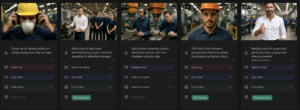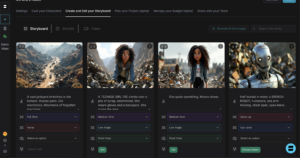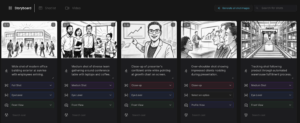Introduction
How to storyboard for corporate video effectively can transform your next marketing campaign from a confusing mess of revisions into a streamlined production that wins stakeholder approval on the first try. Whether you’re creating executive communications, product demos, or training materials, visual planning ensures your corporate message resonates with both internal teams and external audiences.
Corporate video projects often involve multiple stakeholders, tight budgets, and high expectations for professional results. Traditional storyboarding methods can slow down approval processes and create communication gaps between creative teams and executives. That’s why forward-thinking marketers are turning to AI-powered solutions like Shai Creative’s storyboard generator to accelerate their planning process while maintaining creative control.
Ready to streamline your corporate video production and impress your stakeholders? Start your free trial with Shai Creative today and discover how AI can revolutionize your visual planning process.
👉 Explore the AI Storyboard Generator
Why Storyboarding Matters for Corporate Video

Corporate video production faces unique challenges that make storyboarding absolutely essential. Unlike creative projects with flexible timelines, corporate videos operate within strict budget constraints, demanding approval processes, and often unrealistic deadlines. Without proper visual planning, projects spiral into expensive revision cycles that frustrate stakeholders and delay launches.
Storyboarding eliminates the guesswork that plagues corporate video projects. When executives can visualize exactly how their key messages will appear on screen, they make faster decisions and provide more constructive feedback. This visual clarity prevents the all-too-common scenario where stakeholders request major changes after expensive filming has already begun.
The financial impact is significant. Companies that implement thorough storyboarding processes report 40% fewer revision requests and 25% faster project completion times. Visual planning also improves cross-departmental communication, ensuring that legal, compliance, and marketing teams align on messaging before production begins.
Most importantly, storyboarding helps corporate videos achieve their business objectives. By mapping out how each scene supports specific goals—whether that’s increasing product awareness, improving employee engagement, or driving lead generation—marketers create more focused, results-driven content that delivers measurable ROI.
What Makes a Great Storyboard for Corporate Video
Effective corporate video storyboards balance creative vision with practical business requirements. Unlike entertainment storyboards that prioritize emotional impact, corporate storyboards must clearly communicate professional messaging while maintaining viewer engagement throughout often complex topics.
Visual composition plays a crucial role in corporate credibility. Each frame should reflect your brand’s visual identity through consistent color schemes, typography, and imagery styles. Professional framing techniques—like the rule of thirds and appropriate headroom—ensure your executives and spokespeople appear authoritative and trustworthy on screen.
Narrative flow becomes particularly important when explaining complex business concepts or product features. Great corporate storyboards break down complicated information into digestible visual segments, using transitions and pacing to guide viewers through logical progression. This might involve starting with broader context, drilling down to specific features, and concluding with clear calls-to-action.
Technical annotations distinguish professional corporate storyboards from basic sketches. Include detailed notes about lighting requirements (especially for executive interviews), camera movements that support your messaging, and timing specifications that align with platform requirements. Don’t forget practical considerations like logo placement, lower-third graphics, and compliance messaging that legal teams require.
The most successful corporate storyboards also account for stakeholder approval workflows. Design frames that clearly communicate key decision points, making it easy for executives to understand and approve creative concepts without extensive explanation meetings.
👉 Explore the AI Storyboard Generator
Traditional vs AI Storyboarding Tools

Shai’s intuitive interface where users can upload a script and generate visual storyboards, complete with scene sequencing, shot duration, and voiceover options — all in one platform.
Traditional corporate storyboarding relies heavily on hand-drawn sketches or static design software like Photoshop and Illustrator. While these methods offer complete creative control, they create significant bottlenecks in fast-paced corporate environments. Creating even basic storyboard frames can take hours, and making stakeholder-requested changes often requires starting from scratch.
The skill barrier presents another challenge. Not every marketing team includes talented illustrators, leading to rough sketches that fail to communicate professional vision to executives. This often results in miscommunication, where stakeholders struggle to envision the final product based on amateur drawings.
Iteration speed becomes critical when dealing with multiple approval layers. Traditional methods make it time-consuming and expensive to explore different creative directions or incorporate feedback from various departments. By the time visual concepts are refined enough for executive approval, project timelines have often stretched beyond acceptable limits.
AI-powered storyboarding tools like Shai Creative’s AI storyboard generator eliminate these traditional limitations. Advanced algorithms generate professional-quality visual concepts in minutes rather than hours, allowing marketing teams to explore multiple creative directions quickly. The visual consistency ensures that every frame meets corporate standards, while rapid iteration capabilities make stakeholder feedback easy to implement.
Ready to experience the speed and quality of AI-powered storyboarding? Sign up for Shai Creative and see how quickly you can create professional corporate video storyboards.
Step-by-Step: How to Storyboard for Corporate Video
Define Your Story Goal
Start every corporate video storyboard by clearly identifying your primary business objective. Are you introducing a new product to increase sales leads? Training employees on new procedures to improve compliance? Or perhaps building brand awareness among potential clients? Your story goal directly influences every creative decision that follows.
Document your target audience’s specific characteristics, pain points, and preferred communication styles. Corporate audiences often include multiple stakeholder groups—from technical teams to C-level executives—requiring different messaging approaches within the same video. Define success metrics early, whether that’s engagement rates, lead generation, or knowledge retention scores.
Identify Key Scenes or Interactions

Shai storyboard view showing AI-generated frames from uploaded script
Break your corporate message into essential visual moments that support your story goal. Most effective corporate videos follow a proven structure: problem identification, solution introduction, benefit demonstration, and clear next steps. Map these narrative beats to specific scenes that will resonate with your target audience.
Consider the unique requirements of corporate storytelling. Executive interviews require different scene planning than product demonstrations or employee testimonials. Plan for b-roll footage that supports your key messages without distracting from core content. Remember that corporate audiences have limited attention spans, so prioritize your most important messages in early scenes.
Create Visual Frames
Transform your scene concepts into clear visual representations that communicate professional quality to stakeholders. Focus on composition techniques that enhance credibility—appropriate framing for executive interviews, clean product shots that highlight key features, and environment choices that reinforce your brand image.
AI tools dramatically accelerate this phase by generating multiple visual options for each scene concept. Instead of spending hours sketching basic frames, you can quickly explore different compositions, lighting scenarios, and visual styles. This allows more time for strategic thinking about which visuals best support your business objectives.

Add Detailed Annotations
Corporate video storyboards require comprehensive technical notes that guide production teams and satisfy stakeholder requirements. Include specific timing for each scene, especially when coordinating with executive schedules or product demonstrations. Note required graphics, lower-thirds, and any compliance messaging that legal teams mandate.
Document camera movements that support your messaging—subtle push-ins during key points, steady shots for credibility, or dynamic angles for product reveals. Include audio considerations like background music styles, voice-over timing, and any ambient sound requirements that enhance the professional atmosphere.
Review and Collaborate
Implement a structured review process that accommodates corporate approval hierarchies while maintaining project momentum. Share storyboards in formats that non-creative stakeholders can easily understand and provide feedback on. Use collaborative tools that track revisions and maintain version control across multiple review cycles.
AI storyboarding platforms excel at this collaboration phase, offering real-time sharing capabilities and quick revision implementation. When executives request changes, you can generate new visual options immediately rather than scheduling additional creative sessions.
👉 Explore the AI Storyboard Generator
Tips for Optimizing Storyboards for Corporate Video
Align every visual decision with your company’s brand guidelines and corporate messaging standards. Corporate videos reflect directly on your organization’s professionalism, so maintain consistent visual identity throughout all frames. This includes color palettes that match brand standards, typography that reinforces corporate identity, and imagery styles that align with your market positioning.
Plan for multi-stakeholder approval processes by creating storyboards that clearly communicate concepts to non-creative executives. Use descriptive annotations, clear visual hierarchy, and professional-quality frames that help stakeholders envision the final product. Include alternative creative options for key scenes, allowing decision-makers to choose approaches that align with their comfort levels.
Consider various distribution channels during the storyboarding phase. Corporate videos often need versions optimized for different platforms—from internal presentations to social media marketing. Plan framing and composition that works effectively across multiple aspect ratios and viewing contexts.
Build in flexibility for last-minute changes that frequently occur in corporate environments. Executives may need to adjust messaging based on market conditions, compliance requirements, or strategic pivots. Design storyboard structures that can accommodate these changes without requiring complete creative overhauls.
Focus on clear value communication throughout your visual planning. Corporate audiences want to understand benefits quickly and clearly. Use visual techniques like before-and-after comparisons, step-by-step demonstrations, and clear graphic overlays that reinforce key business messages.
Common Mistakes to Avoid
Many corporate video storyboards fail because they prioritize visual creativity over clear business communication. While engaging visuals matter, your primary goal is communicating corporate messages effectively to achieve specific business objectives. Avoid artistic techniques that distract from core messaging or confuse your target audience.
Skipping stakeholder input during the storyboarding phase creates expensive revision cycles later in production. Corporate videos involve multiple departments with different priorities—legal compliance, brand consistency, technical accuracy, and marketing effectiveness. Gather input from all relevant stakeholders before finalizing visual concepts.
Underestimating production logistics leads to unrealistic storyboards that can’t be executed within corporate constraints. Consider available resources, executive schedules, location limitations, and budget restrictions when planning visual concepts. Design storyboards that can be successfully produced within your organizational capabilities.
Ignoring platform-specific requirements results in corporate videos that perform poorly across different distribution channels. LinkedIn videos need different approaches than internal training materials or conference presentations. Plan visual formats and messaging approaches that work effectively for your intended distribution strategy.
Failing to plan for technical integration creates problems when corporate videos need to work with existing systems, presentations, or marketing materials. Consider how your video content will integrate with broader marketing campaigns, sales presentations, or training programs.
Why Use an AI Storyboard Generator Like Shai
AI-powered storyboarding transforms corporate video planning from a time-consuming bottleneck into a rapid, iterative creative process. Shai Creative’s AI storyboard generator produces professional-quality visual concepts in minutes, allowing marketing teams to explore multiple creative directions without extensive manual illustration work.
Speed becomes crucial when corporate deadlines loom and stakeholder approval processes create time pressure. Traditional storyboarding methods can take days or weeks to produce professional-quality visuals, while AI tools generate refined concepts almost instantly. This acceleration allows more time for strategic thinking about messaging effectiveness rather than struggling with basic visual creation.
Quality consistency ensures that every frame meets corporate professional standards. AI-generated storyboards maintain visual coherence across all scenes, preventing the amateur appearance that often results from hand-drawn sketches or inconsistent design work. This professional quality helps stakeholders envision final results and makes approval processes smoother.
Collaboration capabilities built into AI platforms streamline corporate review processes. Real-time sharing, instant revisions, and clear version control help manage the complex approval workflows that corporate videos require. When executives request changes, you can implement modifications immediately rather than scheduling additional creative sessions.
Cost-effectiveness delivers significant value for corporate marketing budgets. AI storyboarding eliminates the need for expensive freelance illustrators or lengthy internal design processes. Teams can produce professional storyboards at a fraction of traditional costs while achieving superior quality and faster turnaround times.
Ready to revolutionize your corporate video planning process? Join thousands of marketers using Shai Creative to create professional storyboards that win stakeholder approval and drive business results.
Final Thoughts + Next Steps
Effective storyboarding transforms corporate video projects from stressful, revision-heavy ordeals into streamlined productions that achieve clear business objectives. By implementing visual planning processes that account for stakeholder approval workflows, brand consistency requirements, and practical production constraints, marketing teams create videos that deliver measurable ROI while maintaining professional credibility.
The key to corporate video success lies in balancing creative vision with business practicality. AI-powered storyboarding tools like Shai Creative provide the speed, quality, and collaboration capabilities that modern corporate marketing demands. Instead of struggling with traditional methods that slow down approval processes, embrace technology that accelerates creative development while maintaining professional standards.
Your next corporate video project deserves the clarity, efficiency, and professional quality that proper storyboarding provides. Don’t let another project suffer from miscommunication, expensive revisions, or missed deadlines. Take action today and discover how AI-powered visual planning can transform your corporate video results.
Start creating professional corporate video storyboards that impress stakeholders and drive business results. Your team—and your budget—will thank you for making the smart choice in visual planning technology.